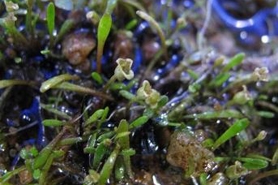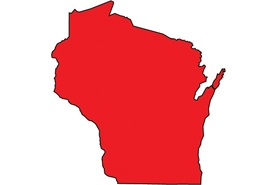Mudmat
(Glossostigma cleistanthum)
A tiny fast-growing aquatic plant that can tolerate a wide range of conditions. It is commonly grown in the aquarium trade and could threaten natural areas if released.
Other names for this plant include:
This plant has been misidentified in other regions as Glossostigma diandrum and has not been extensively searched outside the northeastern United States. It may be underreported.
Classification in Wisconsin: Prohibited
- Ecological Threat
-
- Reported as a speedy rate of growth and likely to survive cold winters.
- Probably introduced to the US as an aquarium plant, then released into natural environments. It could be easily spread by waterfowl.
- Unlike many other wetlands or aquatic invasive plants, mudmat can invade undisturbed, natural environments.
- Identification
-
Leaves: Extremely tiny, bright green leaves grow no larger than 1-2 cm. They are linear-based with broader tips.
Flowers: If submerged, tiny, cleistogamous (self-contained/pollinating) flowers are produced, but if stems are emergent, the plants have small, white, open flowers.
Fruits & seeds: Small capsules are produced that carry seeds. Due to its dense growing habit, thousands of seeds can be made from one square meter of plants.
Stems: Creeping stems grow horizontally below the soil surface and root at the nodes.
Similar species: This plant might be confused with other tiny aquatic creeping plants, particularly in the Limosella or Utricularia families.
- Distribution
-
Currently, there have been no reports of mudmat in Wisconsin Have you seen it? Please send us a report.
- Control
-
Mechanical: Little is documented about controlling this plant. It can spread from fragments so care must be taken to collect and destroy all parts of the plant if pulled.
Chemical: Although little information is documented, registered aquatic herbicides might provide some control. Application of aquatic herbicide requires a permit.
- Resources
- Sources for content:
- USGS Nonindigenous Plant Database Factsheet [exit DNR]
- Connecticut Agricultural Experiment Station Glossostigma information page [exit DNR]


